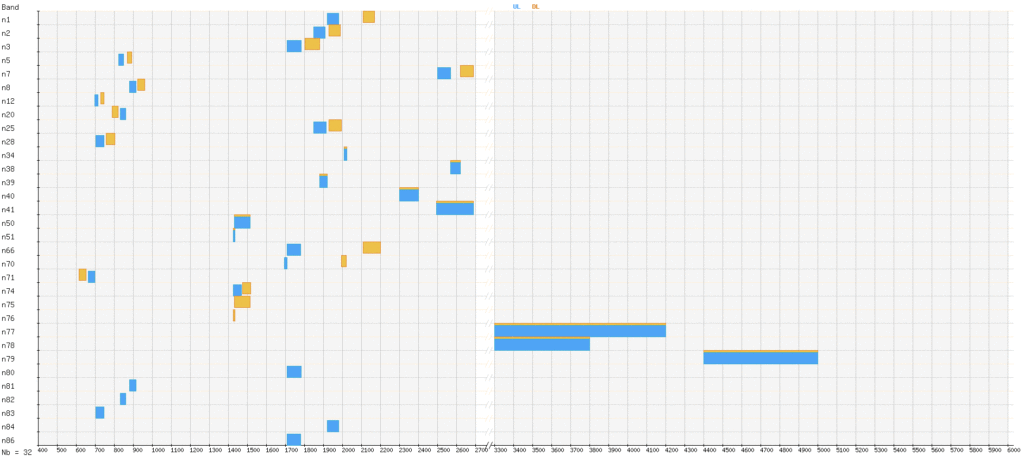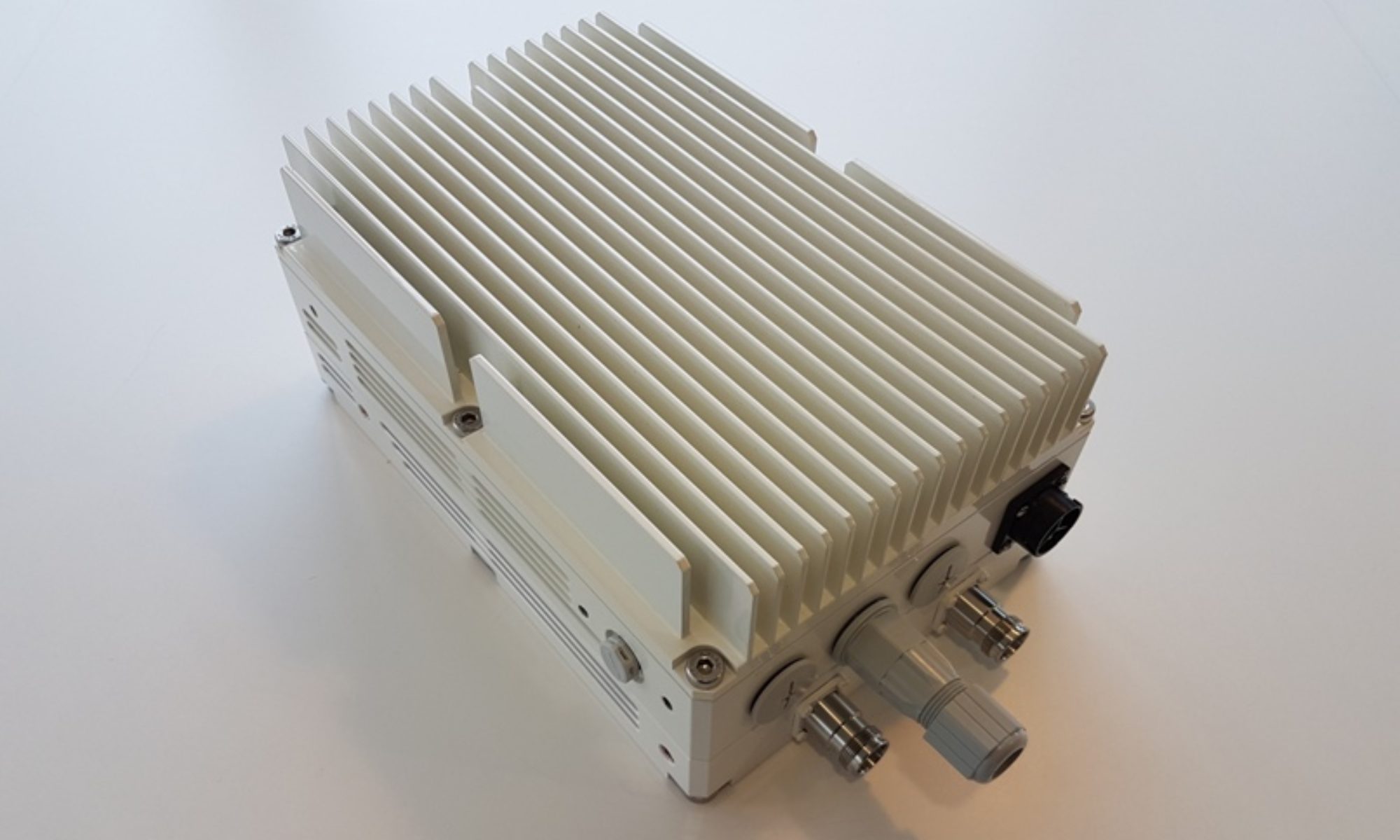Frequency bands for 5G are divided into “sub 6GHz” and “mmWave” bands. “Sub 6” is generally for longer range coverage, with in-building penetration. “mmWave” bands use higher frequencies which offer short range, and no or little penetration of building structures.
This list of 5G frequency bands is taken from the latest published version of the 3GPP TS 38.101,the following tables list the specified frequency bands and the channel bandwidths of the 5G NR standard.
Note that the NR bands are defined with prefix of “n”. When the NR band is overlapping with the 4G LTE band, they share the same band number.
Frequency Range 1
| Band | Duplex mode[A 1] | ƒ (MHz) | Common name | Subset of band | Uplink[A 2] (MHz) | Downlink[A 3] (MHz) | Duplex spacing (MHz) | Channel bandwidths[5] (MHz) |
|---|---|---|---|---|---|---|---|---|
| n1 | FDD | 2100 | IMT | n65 | 1920 – 1980 | 2110 – 2170 | 190 | 5, 10, 15, 20 |
| n2 | FDD | 1900 | PCS[A 4] | n25 | 1850 – 1910 | 1930 – 1990 | 80 | 5, 10, 15, 20 |
| n3 | FDD | 1800 | DCS | 1710 – 1785 | 1805 – 1880 | 95 | 5, 10, 15, 20, 25, 30 | |
| n5 | FDD | 850 | CLR | 824 – 849 | 869 – 894 | 45 | 5, 10, 15, 20 | |
| n7 | FDD | 2600 | IMT‑E | 2500 – 2570 | 2620 – 2690 | 120 | 5, 10, 15, 20 | |
| n8 | FDD | 900 | Extended GSM | 880 – 915 | 925 – 960 | 45 | 5, 10, 15, 20 | |
| n12 | FDD | 700 | Lower SMH | 699 – 716 | 729 – 746 | 30 | 5, 10, 15 | |
| n14 | FDD | 700 | Upper SMH | 788 – 798 | 758 – 768 | −30 | 5, 10 | |
| n18 | FDD | 850 | Lower 800 (Japan) | 815 – 830 | 860 – 875 | 45 | 5, 10, 15 | |
| n20 | FDD | 800 | Digital Dividend (EU) | 832 – 862 | 791 – 821 | −41 | 5, 10, 15, 20 | |
| n25 | FDD | 1900 | Extended PCS[A 5] | 1850 – 1915 | 1930 – 1995 | 80 | 5, 10, 15, 20 | |
| n28 | FDD | 700 | APT | 703 – 748 | 758 – 803 | 55 | 5, 10, 15, 20 | |
| n30 | FDD | 2300 | WCS[A 6] | 2305 – 2315 | 2350 – 2360 | 45 | 5, 10 | |
| n34 | TDD | 2100 | IMT | 2010 – 2025 | N/A | 5 | ||
| n38 | TDD | 2600 | IMT‑E[A 7] | 2570 – 2620 | N/A | 5, 10, 15, 20 | ||
| n39 | TDD | 1900 | DCS–IMT Gap | 1880 – 1920 | N/A | 5, 10, 15, 20, 25, 30, 40 | ||
| n40 | TDD | 2300 | S-Band | 2300 – 2400 | N/A | 5, 10, 15, 20, 25, 30, 40, 50, 60, 80 | ||
| n41 | TDD | 2500 | BRS | n90 | 2496 – 2690 | N/A | 10, 15, 20, 40, 50, 60, 80, 90, 100 | |
| n48 | TDD | 3500 | CBRS (US) | 3550 – 3700 | N/A | 5, 10, 15, 20, 40, 50, 60, 80, 90, 100 | ||
| n50 | TDD | 1500 | L‑Band (EU) | 1432 – 1517 | N/A | 5, 10, 15, 20, 30, 40, 50, 60, 80[A 8] | ||
| n51 | TDD | 1500 | Extended L‑Band (EU) | 1427 – 1432 | N/A | 5 | ||
| n65 | FDD | 2100 | Extended IMT | 1920 – 2010 | 2110 – 2200 | 190 | 5, 10, 15, 20 | |
| n66 | FDD | 1700 | Extended AWS[A 9] | 1710 – 1780 | 2110 – 2200[6] | 400 | 5, 10, 15, 20, 40 | |
| n70 | FDD | 2000 | AWS‑4 | 1695 – 1710 | 1995 – 2020 | 300 | 5, 10, 15, 20[A 8], 25[A 8] | |
| n71 | FDD | 600 | Digital Dividend (US) | 663 – 698 | 617 – 652 | −46 | 5, 10, 15, 20 | |
| n74 | FDD | 1500 | Lower L‑Band (US) | 1427 – 1470 | 1475 – 1518 | 48 | 5, 10, 15, 20 | |
| n75 | SDL | 1500 | L‑Band (EU) | N/A | 1432 – 1517 | N/A | 5, 10, 15, 20 | |
| n76 | SDL | 1500 | Extended L‑Band (EU) | N/A | 1427 – 1432 | N/A | 5 | |
| n77 | TDD | 3700 | C-Band | 3300 – 4200 | N/A | 10, 20, 40, 50, 60, 80, 90, 100 | ||
| n78 | TDD | 3500 | C-Band | n77 | 3300 – 3800 | N/A | 10, 20, 40, 50, 60, 80, 90, 100 | |
| n79 | TDD | 4700 | C-Band | 4400 – 5000 | N/A | 40, 50, 60, 80, 100 | ||
| n80 | SUL | 1800 | DCS | 1710 – 1785 | N/A | N/A | 5, 10, 15, 20, 25, 30 | |
| n81 | SUL | 900 | Extended GSM | 880 – 915 | N/A | N/A | 5, 10, 15, 20 | |
| n82 | SUL | 800 | Digital Dividend (EU) | 832 – 862 | N/A | N/A | 5, 10, 15, 20 | |
| n83 | SUL | 700 | APT | 703 – 748 | N/A | N/A | 5, 10, 15, 20 | |
| n84 | SUL | 2100 | IMT | 1920 – 1980 | N/A | N/A | 5, 10, 15, 20 | |
| n86 | SUL | 1700 | Extended AWS | 1710 – 1780 | N/A | N/A | 5, 10, 15, 20, 40 | |
| n90 | TDD | 2500 | BRS | 2496 – 2690 | N/A | 10, 15, 20, 40, 50, 60, 80, 90, 100 | ||
| Band | Duplex mode[A 1] | ƒ (MHz) | Common name | Subset of band | Uplink[A 2] (MHz) | Downlink[A 3] (MHz) | Duplex spacing (MHz) | Channel bandwidths[5] (MHz) |
- ^ Frequency division duplexing (FDD); time division duplexing (TDD); FDD supplemental downlink (SDL); FDD supplemental uplink (SUL)
- ^ UE transmit; BS receive
- ^ UE receive; BS transmit
- ^ Blocks A–F
- ^ Blocks A–G
- ^ Blocks A–B
- ^ Duplex Spacing
- ^ Downlink only
- ^ Blocks A–J
Chart showing 5G Frequency Bands

Frequency Range 2 (mmWave bands)
| Band | ƒ (GHz) | Common name | Subset of band | Uplink / Downlink[B 1] (GHz) | Channel bandwidths[5] (MHz) |
|---|---|---|---|---|---|
| n257 | 26 | LMDS | 26.50 – 29.50 | 50, 100, 200, 400 | |
| n258 | 24 | K-band | 24.25 – 27.50 | 50, 100, 200, 400 | |
| n260 | 39 | Ka-band | 37.00 – 40.00 | 50, 100, 200, 400 | |
| n261 | 28 | Ka-band | n257 | 27.50 – 28.35 | 50, 100, 200, 400 |
| Band | ƒ (GHz) | Common name | Subset of band | Uplink / Downlink[B 1] (GHz) | Channel bandwidths[5] (MHz) |
- Time division duplexing (TDD) mode
Chart showing 5G mmWave bands

For Further Information
Please Contact Us

